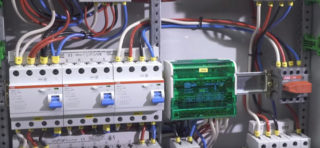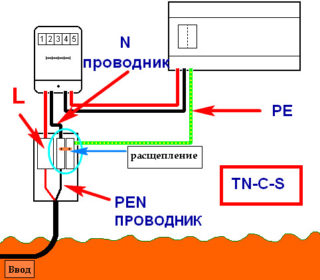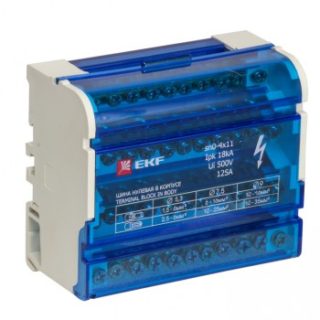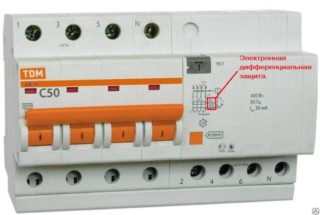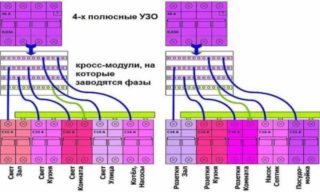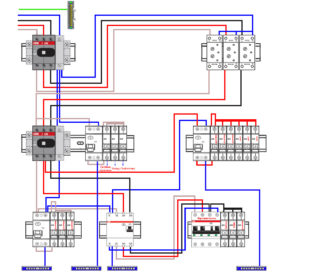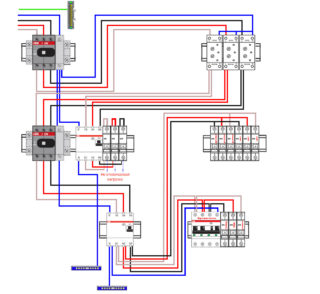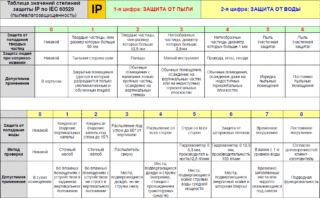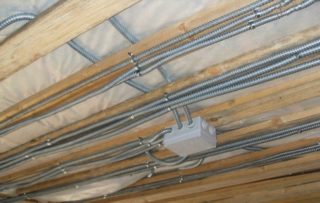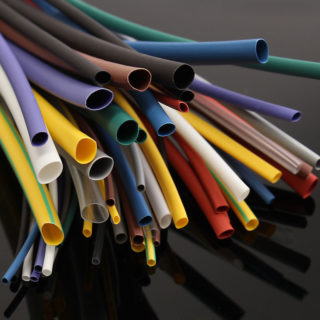The standard parameters of the electric network of private houses are 3 phases, voltage 380 V. Power is allocated 15 kW, and for the wiring a 4-core cable type is used. For this reason, switching and protective devices are closed from illegal connection. Self-assembly of the electrical panel for a private house 380 V 15 kW provides for its installation in a zone accessible for verification and basic application.
Characteristics and specifics of a three-phase network
The 380 V electric network is intended for connecting three-phase and single-phase equipment. In the case of a three-phase connection occurs in 3 phases and neutral to evenly distribute the load of powerful household appliances.
The presence of three phases allows the use of 4-5-core wires with a smaller cross section and difiltomats at 3-4 poles. The allocated power for the 380 V network is divided equally in phases. That is, if 18 kW is allocated, each phase will be 6 kW.
By means of an automatic machine of a three-pole or four-pole type, the line is de-energized in case of increased load of one phase. Given the time delay of the difavtomat, it is required to correctly distribute this load.
Without load distribution, a “phase imbalance” occurs, which leads to a constant turn-off of electricity.
Design and elements of electrical panel
For a three-phase switchboard with a power of 15 kilowatts and a power consumption of 15 kW / h, the following components will be needed:
- Electricity metering device. The counter is installed in the shield immediately. For the home network, electronic models that are highly accurate and reliable are suitable. They work at several rates, display data on a digital display.
- Switchboard. It is a box of various sizes. The street version should have a DIN rail, a lock, a viewing hole for taking readings. The optimum level of dust and moisture protection is IP 54, wall thickness - 1 mm.
- Difavtomat at the input. A three-pole model connected to three phases is suitable.
- RCD An element of protection against the occurrence of dangerous potential on the device body.
- Circuit breaker type. In a private house, a 25 A device is required for input, for a lighting system - 6.3 or 10 A, for a power circuit - 16 A. The power of such a switch is from 7 kilowatts.
- Voltage relay. Prevents damage to household equipment during voltage fluctuations.
- Measuring devices. A voltmeter and an ammeter in one housing are not an obligatory device.
To prevent pulse oscillations and protection against lightning, you can replace the relay with an SPD.
Choosing a three-phase electrical switchboard assembly scheme
The assembly of the 380 shield for the house is carried out according to several schemes. In contrast to the apartment, in addition to protective automation, RCDs are installed in houses, through which lighting is started. The purchase of an element affects the budget of the work, but the power supply system is reliable and safe.
Installation of a distribution box provides for the organization of a grounding line. A private house is grounded according to the schemes:
- TN-C-S. Recommended PUE, but suitable only for new highways with regular maintenance.
- TT. Mounted on the basis of protective devices and ground loop.
The performance of the component grounding circuits is supported by the user.
Using a cross module for a three-phase shield
For ease of assembly of the 380 V switchboard and the possibility of reconnecting the machines to other phases, a cross-module is used. It is placed after the counter. A feature of the device is the presence of three outputs for three phases and several outputs with similar phases.
Through the cross-module, the load is divided into difavtomats. The connection is done like this:
- The end cable is inserted into the socket.
- The core is fixed with a clamping screw.
- To reconnect the phases, the screw is unscrewed, the wire is removed and connected to the free output of the desired phase.
Replace the wires only when overloading one of the phases.
Switchgear assembly 380 V only on differential machines
Difavtomat - a device for a separate line, which works as a regular machine and a device for protection against current leakage. For each group of consumers, you can put a separate device, distributing the load without phase imbalance.
Advantages of the assembly scheme of a three-phase shield on difavtomatov for a country or private house:
- protection of each line from leaks, overloads, short circuits with one device;
- quick search for a problem area in case of breakdowns;
- lack of zero tires;
- selection of the number of difavtomats according to the number of branch lines;
- independent choice of the principle of grouping elements in boxing;
- ease of phase load distribution.
Cons of connection - you will need a dimensional distribution board, more than 72 modules, which is very expensive.
Models with an indication of the cause of the operation determine why the differential machine turned off.
Circuit with two RCDs
Gathering the shield according to the connection diagram with two RCDs at 380 Volts implies the installation of powerful devices at the input. Near each consumer group there are neutral and grounding buses. Zero feeds through a separate mounting rail:
- the element is painted blue with nail polish or acrylic paint;
- after 1 tooth is removed from the tire;
- neutral wire is connected from the bus;
- the teeth are inserted into the grooves and tightened with clamping screws.
After the RCD, a cross-module is placed where the phase starts. Line circuit breakers jump to the exit.
The benefits of the scheme include:
- affordable cost of consumables;
- small boxing dimensions;
- ease of switching one or two consumers from the group.
Cons of the assembly is much greater:
- high costs for three-phase RCD models;
- difficulties with reconnecting group consumers;
- a long search for the cause of the problem;
- disconnection of 50% of consumers from the network at the time of operation of one machine;
- a problem with load balancing and separate placement of wet and dry zones.
The scheme is suitable if you have a summer cottage wooden house, which is used periodically, and not year-round.
To avoid confusing tires, sign them or label them.
One RCD per phase
The circuit can be assembled from two-pole RCDs and cross-modules after each. The load, distributed in phases, jumps to the outputs of the residual current circuit breakers. The neutral and grounding buses will be three - according to the number of RCDs.
Connection benefits include:
- logical distribution of consumer groups;
- shutdown of 20-25% of consumers when one RCD is activated.
The disadvantages are the problematic allocation of "wet" rooms in a separate group without phase imbalance, the time spent on finding breakdowns. To eliminate the minuses, you can assemble each group on a separate din-rail, install an RCD, and then place the machines in series.
Install individual RCDs on hazardous lines.
RCD on input and single-pole machine
The simplest and most popular assembly of a three-phase shield, which prevents future changes in the arrangement of elements. The phase load is distributed only once.The scheme is distinguished by budget cost and is implemented in a small-sized dashboard for 54-72 modules.
At the input, the RCD is installed, and single-pole models are used to distribute the load. PUE limits the user in the number of connection lines. The basis is clause 7.1.83, where it is stated that the leakage current in the total should not exceed 1/3 of the nominal value. Current leakage of the PUE network means 10 μA per 1 m of wire.
The scheme is advantageous in terms of the cost of the elements, the small size of the box, in which there are about 32 modules. Its disadvantages include problems with the grouping, the inability to change the phase load, the presence of zero tires. To equalize the voltage, you will have to almost completely sort out the shield. Otherwise, a strong voltage imbalance, heating of the bus with a burnout of zero and overloading of automatic machines is possible.
Often, an RCD trips in a false mode.
More than three group RCDs
Electricity in a country house and cottage flows through a large number of lines. In the case of installing 3 protective devices, problems arise with the search for damage, a separate group wiring of wet rooms and the street.
A multi-level protection system with individual RCDs after the group will allow you to organize a separate supply of “wet” and “dry” zones. The number of groups in the phase is determined by the number of consumers, the characteristics of the load breakdown and the size of the distribution panel.
Before work, you need to calculate the costs for each node, taking into account the cost of the dyn-rail, bus, cable. The implementation of the introductory shield with more than 3 RCDs, designed for 380 volts, has several nuances:
- in order not to get confused, you need to sign or mark each wire, machine and RCD;
- indicate which phase the conductor is output to. For example, three RCDs were summed up in the first phase. The first indicates L1-1, the second - L1-2, the third - L1-3.
Despite the complexity of the scheme, the system is personalized. If one RCD works, you can detect damage on a specific line. When the device is activated, a small amount of equipment is turned off.
Three-phase load balancing algorithm
The main difficulties in assembling the structure are grouping and even load sharing so that powerful equipment does not cause shutdown due to overload. This will come out with a total power not exceeding the nominal and not simultaneous operation of all devices.
General procedure for grouping the load on the machines
Simple and reliable is a circuit with installation for an individual consumer group or powerful equipment of an individual machine and RCD. The disadvantages of connecting are a large three-phase shield and the cost of its arrangement. An alternative is the supply of several lines to one machine and the correct sequence of combining them:
- To connect outlets and lighting devices, you need to use different machines. This will eliminate the blackout of the entire network if one group breaks down.
- A bathroom, kitchen or bathhouse (“wet areas”) must not be placed in the same group as “dry” ones. Machines for wet environments are selected with different characteristics.
- Street group - lights and sockets are connected to separate automatic devices. It is allowed to combine this group with outbuildings.
- Separate automatic machines are used to power automatic gates, security lighting and ACS.
- To power powerful household appliances, personal RCDs and automatic machines are installed. You can group an electric oven with an electric stove, a washing machine and a dishwasher, a flowing and storage boiler. To avoid overloading, it is not recommended to connect devices at the same time.
For the correct formation of groups, make a list of lines indicating the load of each.
The specifics of assembly flap in a wooden house
The increased degree of combustibility and the risks of fire situations provide for a special procedure for installing the shield in wooden houses. Initially, lumber is impregnated with fire-fighting agents that can hold fire for up to 20 minutes. To exclude the possibility of fire, you will need to adhere to a strict sequence of work.
Nuances of material selection
When selecting materials, the following nuances are taken into account:
- A wooden house may only be electrified with a copper cable. The wire must be marked “ng” and LS is a two-layer non-combustible insulation.
- Conductor cross section selection. You can calculate by formulas or use the table of PUE.
- All wiring points, including outlet lighting, are grounded.
- It is allowed to use a three-, four-wire wire.
- Mandatory RCD installation to protect the breakdown of the body and the ignition of logs.
- Installation for each line or group of a separate machine with power in accordance with the total load on the network.
- Separate shutdown device for each group. For a two-story building, a model of 25 A at the entrance is sufficient and separately for the group - a device at 16 A.
- The choice of outlets depending on the method of wiring - hidden or open.
The meter should be located in front of the introductory machine for easy sealing.
Switchgear Requirements
The correct electrical panel for a house made of wood is metal, which does not come into contact with lumber. The wall thickness of the product is from 1 to 2 mm, but with a short circuit, the electric arc burns through the metal. In this case, you can finish the wall with bricks and put the box on the finished surface. The second version of the interlayer is an asbestos-cement plate or laying several times asbestos fabric cuts under the box.
Useful tips for assembling an electrical panel
To assemble an electrical panel with electricity meters and protective equipment designed for 380 V 15 kW, you will need to purchase a high-quality moisture-resistant box. The wires are thrown onto the machines with special crimping tips, crimped with pliers.
The insulation tape cannot create a reliable coating. It is more convenient to work with heat-shrink tubes, which, when heated by a hairdryer or a lighter, tightly compress the products.
The cores are selected with the same cross section. Different cable cross-sections in one terminal of the switch will lead to melting of the insulation and fires.
The finished box must have marked elements. So it will be easier to turn off the power supply to a separate room. You can sign nodes with a marker or stick paper labels on tape.
The input-distribution device is mounted on a pole from which electricity is supplied. From the power line, a cable is drawn through the shield to the house, and only then the electrical groups are wired. The legislation provides for the separation of the shield on the input and distribution of power supplies.
